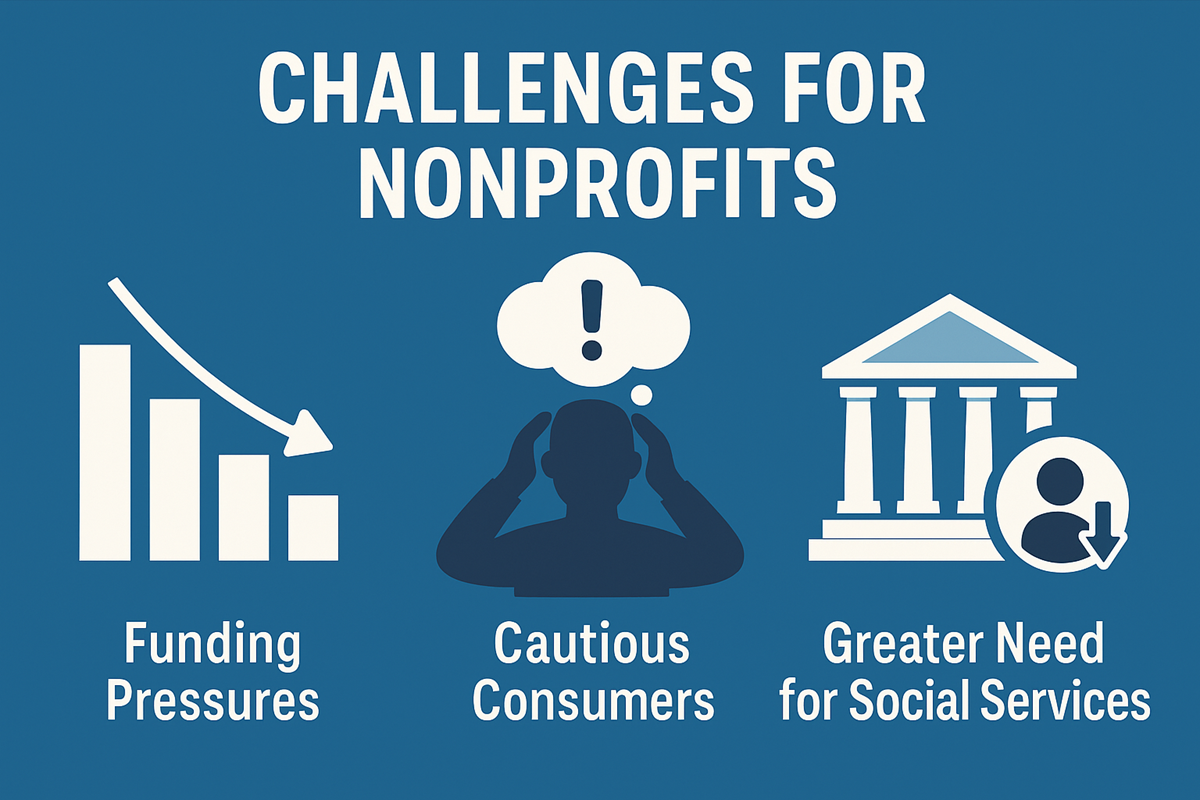Squeezed Nonprofits 2025: The People Problem for Charities (3 of 3)
Introduction: Nonprofit Sector Under Strain
Squeezed nonprofits 2025 across the country are not only struggling financially—they’re struggling to hold onto their most valuable asset: people. This “people problem” spans paid staff, volunteers, board members, and even executive directors. As inflationary pressures persist and burnout rises, many nonprofits are facing record turnover and a shrinking talent pool. The very capacity to deliver mission-critical services is now in question.
This third and final post in the NP2025: Squeezed series explores the staffing crisis, volunteer decline, and emotional toll plaguing nonprofit organizations across the U.S.
📚 This article is part of the “Squeezed Nonprofits 2025” Series – Understanding the Triple Threat Facing Nonprofits in a Time of Crisis:
- Part 1: Strategic Pressure & Financial Stress
Squeezed nonprofits face rising costs and reduced flexibility in 2025. This article explores how to respond strategically when survival is at stake. - Part 2: Vanishing Dollars & Donor Decline
Donor behavior is shifting fast. Learn how to adapt to declining contributions, grant shifts, and changing expectations in the fundraising landscape. - Part 3: The People Problem & Talent Crisis (this article).
Burnout, turnover, and declining volunteerism are squeezing the nonprofit workforce. Explore new models for retaining talent and rebuilding capacity.
Low Wages, High Stakes
Low wages remain one of the most intractable barriers to nonprofit staffing. Even modest cost-of-living increases are difficult for many nonprofits to offer, especially when program budgets are shrinking. In this competitive labor market, highly qualified professionals are understandably migrating toward better-paying roles in government or the private sector.
Burnout and Turnover
The challenge is compounded by a sharp rise in burnout. Many nonprofit staff report feeling overworked, under-resourced, and emotionally exhausted. What used to be a calling has become, for some, a crisis. Executive turnover is especially concerning—when leadership departs, institutional knowledge, donor relationships, and momentum are often lost.
The Volunteer Deficit
Volunteer engagement has also plummeted. Older generations who once made up the volunteer backbone are aging out, and younger adults often lack the time or flexibility. Pandemic-era disruptions have further weakened volunteer pipelines. Some organizations are rethinking their entire approach to community engagement, recognizing that the old models no longer work.
Ripple Effects on Mission Delivery
The impact of these people challenges is severe. Programs are being cut. Waitlists are growing. Staff are wearing too many hats. In some cases, nonprofits are pausing operations simply because they don’t have the human capacity to deliver services.
Solutions Worth Considering
There are steps that can help. Nonprofits should revisit their compensation structures, even if only to improve transparency and equity. Building flexible, meaningful volunteer opportunities can reignite engagement. And AI tools, like ChatGPT, can be deployed to automate administrative tasks—grant writing, donor follow-up, and reporting—freeing up limited staff for mission work.
Collaborate to Compensate
Collaboration is another underutilized solution. Nonprofits can share staff in finance, HR, and marketing roles, reducing overhead and strengthening operations. They can also invest in leadership development pipelines, ensuring the next generation is equipped and inspired to lead.
People Are the Purpose
Ultimately, nonprofits must remember that people are the foundation of purpose. Every donor report, community event, and food pantry delivery starts with human effort. Investing in people isn’t a luxury—it’s a survival strategy.
What You Can Do
Want to help a nonprofit facing people problems? Ask how you can contribute your time, skills, or mentorship. Join a board. Offer your expertise. Together, we can help nonprofits not only survive, but thrive.
Articles were updated June 25, 2025.
Sources / Links
- Nonprofit Workforce Crisis – Johnson Center: https://johnsoncenter.org/blog/the-nonprofit-workforce-is-in-crisis
- 2025 HR Trends in Nonprofits – ADP Spark: https://www.adp.com/spark/articles/2025/03/9-non-profit-hr-trends-you-need-to-know.aspx
- Corporate Volunteer Trends – Double the Donation: https://doublethedonation.com/volunteerism-trends
- Virtual Volunteering Overview – Wikipedia: https://en.wikipedia.org/wiki/Virtual_volunteering
GenAI Prompts
- “Develop a skills-based hiring plan for a nonprofit struggling with staffing shortages.”
- “Create a 3-part volunteer engagement campaign that includes remote and in-person roles.”
- “What wellness initiatives can nonprofits implement affordably to retain talent?”
- “How can nonprofits adapt leadership pipelines to address generational gaps and turnover?”
📎 Article Note:
This article was originally published in early 2025 on NonprofitPlan.org, which has since migrated to Pi-Nonprofit at PerpetualInnovation.org. The content was revised and expanded on June 24, 2025, using Generative AI tools (including ChatGPT-4o) for structural, editorial, and SEO improvements. The original ideas remain author-driven, with AI assisting in refining clarity and format to meet evolving nonprofit sector needs.
✍️ Updated with the support of Pi-CiteRight™, a GenAI disclosure and attribution tool developed by the Strategic Business Planning Company. Final content was reviewed and approved by the human author, Dr. Elmer Hall, on June 24, 2025.
#NonprofitPlan #PerpetualInnovation #NonprofitWorkforce #VolunteerCrisis #SkillsBasedVolunteering #VirtualVolunteering #NonprofitJobs #TalentRetention #WorkforceWellness #SocialSector #ResilientLeadership #AdaptAndThrive

